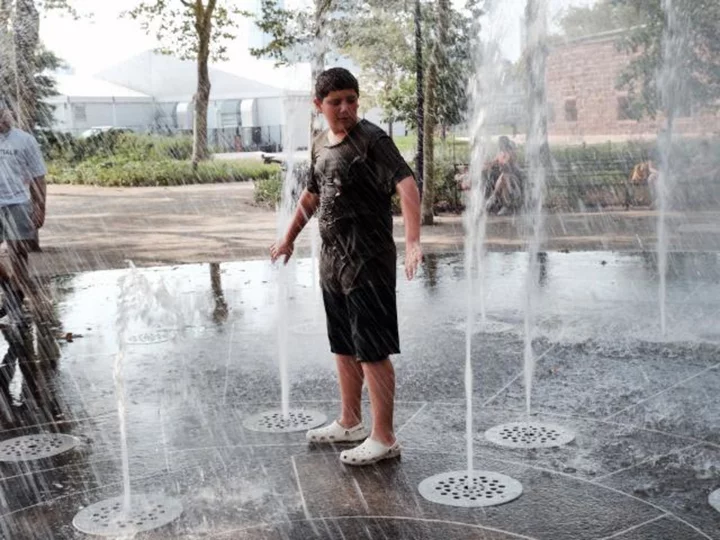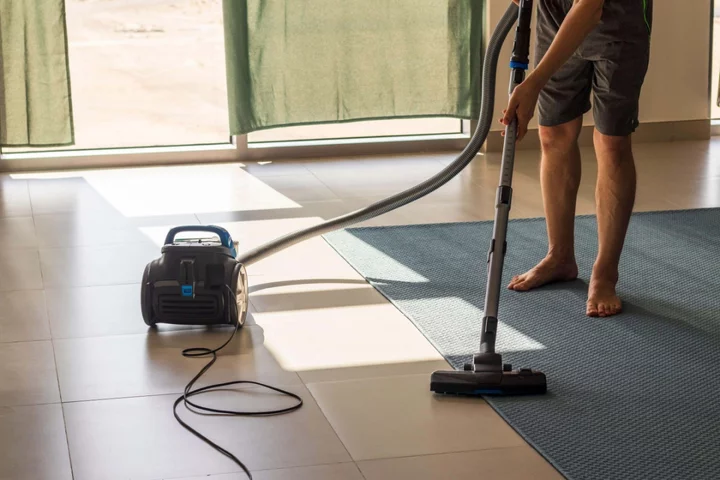
Wind and solar are propping up the Texas power grid amid a brutally long heat wave
As Texas bakes under a sweltering heat dome, the power has stayed on and prices haven't spiked tremendously. Thank wind and solar, energy experts say.
1970-01-01 08:00

After McConnell Freezes at News Conference, Senate Republicans Stand by Him
Senate Republicans are standing by their leader Mitch McConnell as they leave for the long August recess, brushing
1970-01-01 08:00

Kenya cyber-attack: Why is eCitizen down?
A key government online platform has been down for several days and mobile money services are also affected.
1970-01-01 08:00

Lost for centuries, Emperor Nero's theater is unearthed in Rome
Ruins of a private theater belonging to the 1st century Roman Emperor Nero have been unearthed in the Italian capital just meters from the Vatican, in what experts are calling an "exceptional" find.
1970-01-01 08:00

Bode Miller says his toddler son Asher was hospitalised for carbon monoxide poisoning
Bode Miller has revealed that his three-year-old son, Asher, was hospitalised for carbon monoxide poisoning. The US Olympic alpine skier - who shares sons Nash, eight, Easton, four, twin sons Asher and Askiel, three, and daughter Scarlet Olivia, 19 months, with wife Morgan Miller - shared in a since-deleted Instagram post on 27 July that the incident came after a construction crane was parked in the driveway of their home. “Earlier this week we had a crane parked in our driveway for a few hours. Despite keeping the kids inside for obvious safety reasons, the little ones got really sick from it,” he captioned the deleted post, according to People. “Asher ended up in the hospital with carbon monoxide poisoning,” Miller said. “All are well now, but passing along as a reminder to all parents of the dangers of carbon monoxide. Reminder to go test your CO detectors.” While Miller’s post has since been deleted, his wife Morgan shared her own Instagram post about the incident on 28 July. “Receiving a lot of messages so addressing it here,” she captioned her video, which showed her three youngest children wearing oxygen masks in the hospital. “Two weeks ago, we had a crane at our house to remove our broken hot tub. Asher, Aksel and Scarlet innocently stood on the front step of our house to watch the action which resulted in them getting carbon monoxide poisoning due to the lack of airflow in our driveway landing them in the ER,” Morgan revealed. “They were on high flow oxygen for over four hours. It was a terrifying experience but thanking my lucky stars they are okay.” When asked by an Instagram follower how she recognised the signs of carbon monoxide poisoning, Morgan explained that Asher “was complaining of an upset stomach” and he appeared as “white as a ghost”. Asher then began to pass out, which prompted her to rush the toddler to the emergency room. While his tests came back normal, Morgan instructed her nanny to check if her other children were having any symptoms of poisoning. The nanny informed her that Aksel started to have the same symptoms as his twin brother. “I notified the nurse and she said if there’s ever more than one with the same symptoms then they check for carbon monoxide poisoning and sure enough that’s what it was,” Morgan said. “They had us clear the house and bring everyone down to get tested and they sent the fire department up to check our home.” In a separate comment, the professional beach volleyball player revealed that the family has carbon monoxide detectors in their house, but none of them went off. Carbon monoxide poisoning occurs when too much carbon monoxide is in the air, causing the body to replace oxygen in red blood cells with carbon monoxide. According to the Mayo Clinic, some of the symptoms of carbon monoxide poisoning include headache, weakness, dizziness, nausea or vomiting, shortness of breath, blurred vision, drowsiness, loss of muscle control and loss of consciousness. The recent health scare comes after their son Asher was rushed to the hospital following a febrile seizure in December – a convulsion in a child that’s caused by a fever. “Yesterday, Asher had a febrile seizure which scared us half to death. We took that same ambulance to the same hospital we took Emmy to but this time we got to leave with our child,” Morgan wrote in an Instagram Story at the time, alongside a photo of her husband lying down on a hospital bed with Asher asleep on his chest. Their daughter, Emmy, died in an accidental drowning incident in 2018 when she was 19 months old. In a separate Story, Morgan also shared a picture of the pro skier cuddling with his twin sons on the couch after they had brought Asher home from the hospital. “He’s home and back to his normal self,” she said. “I am reminded to slow down and realise life’s little gifts during this crazy holiday season because we already have everything we need… our loved ones, our health, and more time”. “Because time with the ones we love is all we could ever ask for,” she wrote over the final photo, which showed Miller looking affectionately at his three-year-old son. He is also father to daughter Dace, 14, and son Nate, 10, from previous relationships. In June 2018, their daughter Emeline died in a drowning accident at 19 months old. The child was found unconscious at a neighbour’s swimming pool in southern California. Miller, who has won six Olympic medals in alpine ski racing, shared at the time that he and his family were “beyond devastated”. “We are beyond devastated. Our baby girl, Emmy, passed away yesterday. Never in a million years did we think we would experience a pain like this,” he shared in an Instagram post, which featured a picture of his daughter. “Her love, her light, her spirit will never be forgotten. Our little girl loved life and lived it to its fullest every day. Our family respectfully requests privacy during this painful time.” Read More Bode Miller reveals three-year-old son was hospitalised after seizure Olympic gold medal-winning skier Bode Miller's 19-month-old daughter drowns in swimming pool Bode and Morgan Miller urge other parents to remain vigilant at pools after their daughter drowned The two best exercises for lowering blood pressure, according to study Experts reveal the most unhygienic things in your kitchen – and how to get them clean Hepatitis B and C could cause ‘significantly higher cancer risk’ than smoking daily pack of cigarettes
1970-01-01 08:00

The two best exercises for lowering blood pressure, according to study
Exercises such as “wall sits” could be the best form of activity to help people reduce blood pressure, a new study suggests. Other physical activity including cardio, resistance training and HIIT workouts are also good for bringing down resting blood pressure levels, researchers found. But isometric exercises – those that involve engaging muscles without movement, such as wall sits and planks – provide the best results, they said. The study, published in the British Journal of Sports Medicine, saw researchers conduct analysis on previous studies looking at exercise and blood pressure. Some 270 studies were included in the final analysis which contained data on almost 16,000 people. They examined the impact different exercises had on systolic blood pressure, which notes the force at which the heart pumps blood around the body; and diastolic blood pressure, the resistance to the blood flow in the blood vessels between heartbeats when blood is pumped around the heart. The researchers, led by academics at Canterbury Christ Church University in Kent, found that there were significant reductions in resting blood pressure following cardio (aerobic exercise); dynamic resistance training, such as squats, press-ups and weights; high intensity interval training (HIIT); and combined training and HIIT. But the largest reductions were seen after isometric exercise training. A secondary analysis on specific types of exercises found the most benefit was seen among those who performed “isometric wall squats” and among runners. The academics said that current exercise recommendations for the prevention and treatment of high blood pressure are based on “older data” and suggest that it may be time to review the current guidelines. “Aerobic exercise training, dynamic resistance training, combined training, high-intensity interval training and isometric exercise training are all significantly effective in reducing resting systolic and diastolic blood pressure,” they wrote. “Overall, isometric exercise training is the most effective mode in reducing both systolic and diastolic blood pressure. “These findings provide a comprehensive data driven framework to support the development of new exercise guideline recommendations for the prevention and treatment of arterial hypertension.” For the average adult high blood pressure is considered to be from 140/90mmHg. When a person’s blood pressure is too high it puts extra strain on blood vessels, heart and other organs, such as the brain, kidneys and eyes. Persistent high blood pressure can lead to a number of serious health problems including heart attacks, strokes and vascular dementia. While there are medications which can help, people can make a number of life-style changes to help bring their blood pressure down including regular exercise, losing weight, cutting back on caffeine, alcohol and salt. Read More Dating app screenshot culture is out of control Husband fired from family business after wife roleplayed with reborn dolls The bowel cancer symptom George Alagiah wished he’d caught earlier Charity boss speaks out over ‘traumatic’ encounter with royal aide Ukraine war’s heaviest fight rages in east - follow live
1970-01-01 08:00

Biogen to Buy Reata for $7.3 Billion in Rare-Disease Expansion
Biogen Inc. agreed to acquire Reata Pharmaceuticals Inc. for $7.3 billion including debt to expand its rare disease
1970-01-01 08:00

Drugmakers go under the skin, skirting early US Medicare price negotiations
By Michael Erman NEW YORK Injectable versions of some widely-used cancer drugs including Johnson & Johnson's blockbuster multiple
1970-01-01 08:00

Experts reveal the most unhygienic things in your kitchen – and how to get them clean
It’s likely there are countless things in your kitchen which look clean, but actually, they’re filthy. Could your dishcloths be making you sick? When was the last time you washed your tea towels? And do we really need to bleach the sink more than once a month? We asked an expert to find out. Knobs, door handles, and buttons The buttons and dials on your kitchen appliances could be a germ-fest. “People often neglect to clean these areas of the kitchen,” says Danielle Mason, a cleaning content creator – or ‘cleanfluencer’ – who creates tutorials and videos on TikTok and Instagram. “Most of the time, they don’t think it is important, but as you’re commonly handling raw meat and food, it’s extremely important to keep these areas clean, due to cross-contamination. “Always sanitise with a cloth – I like to do this with Zoflora, as it leaves a great smell afterwards, and kills bacteria from dirty fingers.” Cloths If what you clean with isn’t clean, chances are, your kitchen isn’t either. “I always leave my cloth to soak in bleach before going to bed every night,” says Mason. “This enables a new start in the morning with no bacteria. Also, make sure you’re replacing the cloths – I would suggest a new one every two weeks, whilst still bleaching every night. And make sure you’re not using this cloth on anything other than the kitchen, as you do not want to cross-contaminate.” Sponges Mason stresses sponges are unhygienic, as they’re constantly damp and can carry E. coli. “People tend not to use sponges, as they carry so many more germs, and even putting them in the microwave will not kill all of them. Avoid a sponge where possible.” Dish towels Dish towels and tea towels may not be changed anywhere near often enough. “You should have one for every day of the week, as they carry so many bacteria and germs, which get spread across the kitchen. If you’re drying pots and pans, and then wiping down your surfaces, it’s not good,” she says. Chopping boards Chopping boards – particularly wooden ones – could be a haven for bacteria. “You should have a different colour for different types of food, one for meat, fruit, and other foods,” advises Mason. “The best way to clean them is in a dishwasher, as it’s good to get rid of all the germs due to the very high heat. If you don’t like the dishwasher, then boil the kettle water and leave the chopping boards to soak in it. I use a steam cleaner on mine, as it kills 99.9% bacteria and there are no chemicals.” It is best to avoid wooden chopping boards altogether, as these cleaning methods may damage them. Kitchen sink “This is a massive breeder of bacteria and grime; a distinct microbiome is found in sinks. “The plumbing area found beneath sinks revealed microbial communities dominated by a group of bacteria called Proteobacteria. This phylum includes pathogens such as Salmonella and E. coli, which can cause serious disease,” Mason shares. “I’ve always been taught never to wash my hands in the sink, and to never throw dirty water down the sink. You wash your cups and plates in the sink and prepare food, so it should always be kept clean, and nothing from outside the kitchen should cross-contaminate that. For example, never wash your floors and put dirty water in your kitchen sink, always throw it down the toilet.” How do you possibly clean the inside of your sink and drains? “Baking soda and vinegar is the best way to clean your sink out, or bleach, but you must be careful with bleach, as it can stay in the bottom of your sink, depending on the material it’s made of. I clean my sink out every day.” Pipes and cupboards around your sink could be leading you to have a rodent problem. “You can prevent mice and rodents from entering the kitchen by covering any small crevices or cracks. It is also important to repair leaks as soon as they happen, as they can come through the pipes,” she says. Fridges “Deep clean [your fridge] every two months. A normal cleaning – the wiping of shelves – should be done every other day with soapy water. For any bad smells, use baking soda, which will absorb the smell from the fridge,” Mason continues. “The fridge is a breeding ground for salmonella, E. Coli and other bacteria.” Bins Where you throw your waste away could be a breeding ground for germs. “Make sure you keep [outdoor] rubbish bins away from your house, and make sure you empty your bin as soon as it’s full,” advises Mason. “I personally do not keep a bin in the kitchen, I use a bag and I take that out by the end of the day, but if you are using a bin, make sure you bleach it with hot kettle water, to keep it smelling fresh.” Read More This is why you keep waking up at 4am – and what you can do about it TV chef James Martin reveals cancer diagnosis in apology over ‘bullying’ allegations Bursts of activity that make you huff and puff ‘linked to reduced cancer risk’ Charity boss speaks out over ‘traumatic’ encounter with royal aide Ukraine war’s heaviest fight rages in east - follow live
1970-01-01 08:00

Northeast and Midwest set to bake under intense heat this weekend
Scorching temperatures will continue to smother millions from the Midwest to the Northeast on Friday and into the weekend, triggering emergency mode for cities and testing nation's largest power grid.
1970-01-01 08:00

Bursts of activity that make you huff and puff ‘linked to reduced cancer risk’
Short bursts of daily activity that make you huff and puff – such as playing high-energy games with children – could help reduce the risk of cancer, research suggests. According to the study, a total of just four-and-a-half minutes of vigorous activity – done in bursts of around one minute each – during daily tasks could reduce the overall risk of cancer by 18 per cent, and the risk of some cancers linked to physical activity by up to 32 per cent. Other activities could include vigorous housework, carrying heavy shopping around the supermarket, or bursts of power walking. Lead author Professor Emmanuel Stamatakis, of the Charles Perkins Centre, University of Sydney, Australia, said: “We know the majority of middle-aged people don’t regularly exercise, which puts them at increased cancer risk, but it’s only through the advent of wearable technology like activity trackers that we are able to look at the impact of short bursts of incidental physical activity done as part of daily living. “It’s quite remarkable to see that upping the intensity of daily tasks for as little as four to five minutes a day, done in short bursts of around one minute each, is linked to an overall reduction in cancer risk by up to 18 per cent, and up to 32 per cent for cancer types linked to physical activity.” Cancer types linked to physical activity are those where not exercising increases the risk of developing the disease. The cancers associated with physical activity included liver, lung, kidney, gastric cardia (a type of stomach cancer), endometrial, myeloid leukaemia, myeloma, colorectal, head and neck, bladder, breast and esophageal adenocarcinoma (cancer of the oesophagus). Published in Jama Oncology, the study used data from wearable devices to track the daily activity of more than 22,000 people who do not exercise. Researchers then followed the group’s clinical health records for close to seven years to monitor for cancer. They found that as few as four to five minutes of vigorous intermittent lifestyle physical activity (Vilpa) was associated with a substantially lower cancer risk compared with those who undertook no Vilpa. Vilpa was coined by researchers at the University of Sydney’s Charles Perkins Centre to describe the very short bursts of activity – around one minute each – we do with gusto each day. Vilpa is a bit like applying the principles of high-intensity interval training (HIIT) to your everyday life Professor Emmanuel Stamatakis, University of Sydney Prof Stamatakis said: “Vilpa is a bit like applying the principles of high-intensity interval training (HIIT) to your everyday life.” He added that adults who do not exercise are at increased risk of developing certain cancers such as breast, endometrial or colon. But, until recently, experts were not able to measure the impact of less structured forms of vigorous physical activity. In the study sample of 22,398 people with an average age of 62 who did not exercise in their leisure time, the researchers found 2,356 new cases of cancer (1,084 in physical activity-related cancer) over an average follow-up of 6.7 years. They found that a minimum of around 3.5 minutes of daily Vilpa was associated with up to an 18% reduction in cancer incidence, compared with no Vilpa, while 4.5 minutes of daily Vilpa was associated with up to a 32% reduction in the risk of cancers linked to physical activity. The researchers used data from the UK Biobank Accelerometry Sub Study and only included people who reported no leisure time exercise and no regular recreational walks. Read More TV chef James Martin reveals cancer diagnosis in apology over ‘bullying’ allegations Men have a problem – and it won’t be solved by either Andrew Tate or Caitlin Moran Husband fired from family business after wife roleplayed with reborn dolls
1970-01-01 08:00

Global Bonds Fall as Japan Tweaks Yield Control: Markets Wrap
Bonds around the world retreated after the Bank of Japan, so far a holdout on ultra-loose monetary policy,
1970-01-01 08:00
